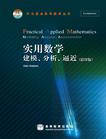实用数学(影印版)
出版时间:2008 年3月 出版社:高等教育出版社 作者:豪伊森 页数:326
Tag标签:无
内容概要
《实用数学:建模分析逼近(影印版)》内容分为三部分:建模,讲述了建模的一些原则(包括物理定律、本构关系及守恒定律),量纲分析(包括Buckingham的Pi定理)等;分析技巧,讲述了偏微分方程和广义函数的基础知识;渐近分析,讲述了渐近展开的基本概念,正则摄动展开,边界层和多重尺度法等。
书籍目录
PrefacePart Ⅰ Modelling techniques1 The basics of modelling1.1 Introduction1.2 What do we mean by a model?1.3 Principles of modelling: physical laws and constitutive relations1.4 Conservation laws1.5 General remarks1.6 Exercises2 Units, dimensions and dimensional analysis2.1 Introduction2.2 Units and dimensions2.3 Electric fields and electrostatics2.4 Sources and further reading2.5 Exercises3 Nondimensionalisation3.1 Nondimensionalisation and dimensionless parameters3.2 The Navier-Stokes equations and Reynolds numbers3.3 Buckinghams Pi-theorem3.4 Sources and further reading3.5 Exercises4 Case studies: hair modelling and cable laying4.1 The Euler-Bernoulli model for a beam4.2 Hair modelling4.3 Undersea cable laying4.4 Modelling and analysis4.5 Sources and further reading4.6 Exercise5 Case study: the thermistor (1)5.1 Heat and current flow in thermistors5.2 Nondimensionalisation5.3 A thermistor in a circuit5.4 Sources and further reading5.5 Exercises6 Case study: electrostatic painting6.1 Electrostatic painting6.2 Field equations6.3 Boundary conditions6.4 Nondimensionalisation6.5 Sources and further reading6.6 ExercisesPart Ⅱ Analytical techniques7 Partial differential equations7.1 First-order quasilinear partial differential equations: theory7.2 Example: Poisson processes7.3 Shocks7.4 Fully nonlinear equations: Charpits method7.5 Second-order linear equations in two variables7.6 Further reading7.7 Exercises8 Case study: traffic modelling8.1 Simple models for traffic flow8.2 Traffic jams and other discontinuous solutions8.3 More sophisticated models8.4 Sources and further reading8.5 Exercises9 The delta function and other distributions9.1 Introduction9.2 A point force on a stretched string; impulses9.3 Informal definition of the delta and Heaviside functions9.4 Examples9.5 Balancing singularities9.6 Greens functions9.7 Sources and further reading9.8 Exercises10 Theory of distributions10.1 Test functions10.2 The action of a test function10.3 Definition of a distribution10.4 Further properties of distributions10.5 The derivative of a distribution10.6 Extensions of the theory of distributions10.7 Sources and further reading10.8 Exercises11 Case study: the pantograph11.1 What is a pantograph?11.2 The model11.3 Impulsive attachment for an undamped pantograph11.4 Solution near a support11.5 Solution for a whole span11.6 Sources and further reading11.7 ExercisesPart Ⅲ Asymptotic techniques12 Asymptotic expansions12.1 Introduction12.2 Order notation12.3 Convergence and divergence12.4 Further reading12.5 Exercises13 Regular perturbation expansions13.1 Introduction13.2 Example: stability of a spacecraft in orbit13.3 Linear stability13.4 Example: the pendulum13.5 Small perturbations of a boundary13.6 Caveat expandator13.7 Exercises14 Case study: electrostatic painting (2)14.1 Small parameters in the electropaint model14.2 Exercises15 Case study: piano tuning15.1 The notes of a piano: the tonal system of Western music15.2 Tuning an ideal piano15.3 A real piano15.4 Sources and further reading15.5 Exercises16 Boundary layers16.1 Introduction16.2 Functions with boundary layers; matching16.3 Examples from ordinary differential equations16.4 Case study: cable laying16.5 Examples for partial differential equations16.6 Exercises17 Case study: the thermistor (2)17.1 Strongly temperature-dependent conductivity17.2 Exercises18 Lubrication theory analysis in long thin domains18.1 Lubrication theory approximations: slender geometries18.2 Heat flow in a bar of variable cross-section18.3 Heat flow in a long thin domain with cooling18.4 Advection-diffusion in a long thin domain18.5 Exercises19 Case study: continuous casting of steel19.1 Continuous casting of steel19.2 Exercises20 Lubrication theory for fluids20.1 Thin fluid layers: classical lubrication theory20.2 Thin viscous fluid sheets on solid substrates20.3 Thin fluid sheets and fibres20.4 Further reading20.5 Exercises21 Case study: turning of eggs during incubation21.1 Incubating eggs21.2 Modelling21.3 Exercises22 Multiple scales and other methods for nonlinear oscillators22.1 The Poincare-Linstedt method22.2 The method of multiple scales22.3 Relaxation oscillations22.4 Exercises23 Ray theory and the WKB method23.1 Introduction23.2 Classical WKB theory23.3 Geometric optics and ray theory: why do we say light travels in straight lines?23.4 Kelvins ship waves23.5 ExercisesReferencesIndex
图书封面
图书标签Tags
无
评论、评分、阅读与下载
